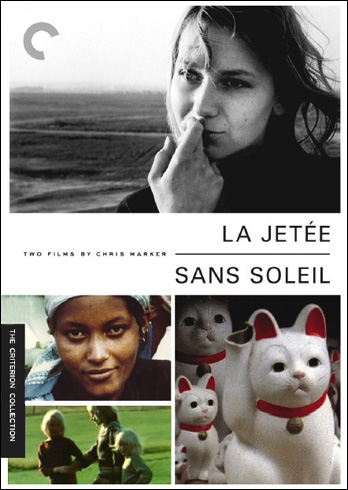- Sans Soleil
Infobox Film
name = Sans Soleil

caption =Criterion Collection DVD packaged with "La Jetée "
director =Chris Marker
producer =
writer = Chris Marker (as Sandor Krasna)
narrator = Florence Delay (French version)
Riyoko Ikeda (Japanese version)
Charlotte Kerr (German version)
Alexandra Stewart (English version)
music = Chris Marker (as Michel Krasna)
cinematography = Chris Marker (as Sandor Krasna)
editing = Chris Marker
distributor = Argos Films
released = 1983
runtime = 100 min.
country =France
awards =
language = French
budget =
preceded_by =
followed_by =
amg_id = 1:42824
imdb_id = 0084628"Sans Soleil" ("Sunless" in English) is a 1983 film by French director
Chris Marker . The title is taken from the song cycle "Sunless" byModest Mussorgsky .ynopsis
Stretching the genre of documentary, this experimental essay-film is a rich composition of thoughts, images and scenes, mainly from
Japan andGuinea-Bissau , "two extreme poles of survival". Some other scenes were filmed inIceland ,Paris , andSan Francisco . A female narrator reads from letters supposedly sent to her by the (fictitious) cameraman Sandor Krasna.Sans Soleil is often labeled as a documentary or travelogue, however it contains fictional elements and moves from one location to another without regard to a location or character-based narrative.
Themes
Much of "Sans Soleil" is a meditation on the nature of human memory and the inability to recall the context and nuances of memory and as a result, how the perception of personal and global histories are affected.
Introductory quotations
The original French version of "Sans Soleil" opens with the following quotation by
Jean Racine from his tragedy "Bajazet" (1672):"L'Éloignement des pays répare en quelque sorte la trop grande proximité des temps."(The distance between countries compensates somewhat for the excessive closeness of time.)
Marker replaced this quote with the following one by
T. S. Eliot from "Ash Wednesday" (1930) for the English version of the film:"Because I know that time is always time
And place is always and only place
And what is actual is actual only for one time
And only for one place". ["Racine/Eliot" from booklet accompanying La Jetée/Sans Soleil DVD produced by Criterion]Technical information
"Sans Soleil" contains some
stock footage , clips from Japanese film and television, and a few excerpts from other films. The original documentary footage was filmed by Marker with a 16mm Beaulieu silent film camera in conjunction with a non-sync portable tape recorder; the film contains no synchronous sound. ["Notes on Filmmaking", essay by Chris Marker in booklet accompanying La Jetée/Sans Soleil DVD produced by Criterion] . Some of the stock footage shots were colorized with a Spectron video synthesiser.Influences
The sequence in San Francisco references
Alfred Hitchcock 's "Vertigo" and Marker's own earlier film "La Jetée ". Marker's use of the name "The Zone" to describe the space in which Hayao Yamaneko's (who is, in fact, Marker himself) images are transformed is an homage to " Stalker", a film byAndrei Tarkovsky , as noted in one of the letters read in the film.Notes
External links
*imdb title|id=0084628|title=Sans Soleil
* [http://www.markertext.com/sans_soleil.htm Full text of the film]
* [http://www.geocities.com/wolfgang_ball/ A critical reading of the film]
Wikimedia Foundation. 2010.
